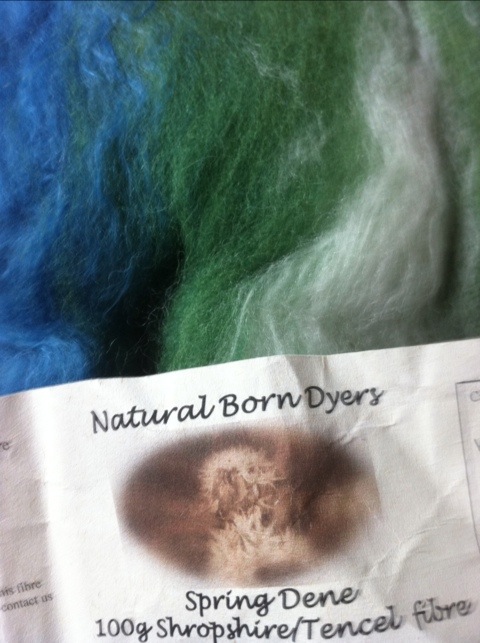
It’s been a while, but happily, I’ve been getting back to spinning a little bit more lately. I’ve the start of a lovely double knitting weight yarn on the go that is intended to be knitted into a beret. It’s the yellow affair on the bottom left in the picture of the 1960s Copley’s leaflet above. Perhaps I shall make it without the bobble and instead add a button. As you can see, it’s a plain knit and I have selected it as such to show off the yarn that I make. The fibre that I’m using to spin it up is a beautiful shropshire/tencel mix from Natural Born Dyers, seen below. It’s a dream to spin on the wheel and is making a good, springy yarn to work with.

Whilst talking about spinning with a friend, we both found that despite no longer really being novice spinners, there were still some terms that we weren’t entirely sure of. We looked some up and learned a few new words, and so I thought that it might be useful to update the post that I wrote for Historic Crafts a little while ago, to include som of them here for you too. I wonder how many of you are spinners?
Some useful terms that you might come across:
Batt: Thick sheet of carded fibres.
Blending: Combining more than one fibre or colour together so that they act as one. Done by carding.
Bobbin: Holds the yarn once it is spun.
Break: A weakness in one part of the staple (due to thinning of the wool fibres)
Butt end: The end of the staple that has been shorn from the sheep: the cut end.
Carding: Breaking up a compact fibre mass to five it less density and make it more even. Carried out using carders.
Combing: Using a metal comb to separate the tip of the staple. Also removes any dirt or twigs in the wool.
Crimp: The wave pattern in a staple of wool
Crossbreed: The wool of a longwool sheep
Drafting: The pulling out and reducing of fibres carried out as part of the spinning process.
Drive Ratio: On a spinning wheel, the amount of times that the flyer turns in relation to one turn of the wheel.
Drum Carder: A mechanical tabletop device with rollers with teeth, for carding large amounts of wool.
Flick Carding: Preparing the wool for spinning using a small wooden batten with metal teeth against a firm surface such as leather.
Flyer: The part of the spinning wheel that holds the bobbin and that is connected to the wheel by the drive belt.
Fulling: Washing and finishing process for woolen cloth.
Kemp: Short course fibres found in some fleeces. Do not take dyes well.
Lazy Kate: Holder for the bobbins when plying on a wheel.
Loft: The airiness of the wool.
Micron: One millionth of a metre. Used to denote the density of wool.
Navajo Plying: A method of creating a 3-ply yarn from a single strand.
Niddy Noddy: Piece of kit used for winding yarns into skeins.
Orifice: An opening on the end of the spindle shaft of the wheel, through which the yarn passes on its way to the bobbin.
Plying: Spinning single yarns together to form a plied yarn.
Resiliance: The ability of wool to bounce back to its original shape/dimensions after being compressed.
Rolag: A coil of wool, made by hand carding.
Roving: A long, continuous piece of carded wool fibres which has been slightly twisted.
S-spun yarn: Yarn spun in an anticlockwise direction: often plied.
Scouring: Removing the natural grease and dirt in a fleece or wool in general.
Single: A single strand of spun yarn.
Staple: A lock of fleece.
Staple Length: The length of said lock of fleece: differs between sheep.
Top: A continuous piece of combed wool.
Yolk: The mixture of wax and sweat found in wools
Z-spun yarn: Yarn spun in a clockwise direction: often singles, prior to plying.
Worsted Yarn: Usually spun from long-stapled fleeces, using a short drafting technique.
Woollen Yarn: Usually spun from short-stapled fleeces, hand carded into rolags, using a medium draft or long-draw technique.

